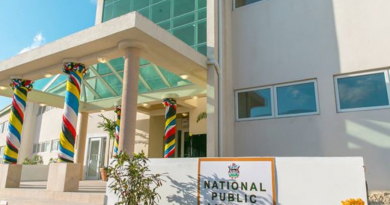Teeming Emergency Room faces shortage of nurses, not doctors, hospital management reports to Cabinet
While there are reports of Emergency Room (ER) doctors working
for longer than normal hours, the medical director at the Sir Lester
Bird Medical Centre, Dr. Albert Duncan, says there is no shortage of
physicians in the ER – but there is a shortage of nurses.
Dr. Duncan and four other management officials reportedly met
with the Cabinet on February 14 to update the Executive on several
improvements taking place at the public hospital.
This week’s Notes claim that, for more than an hour, the hospital
officials answered the “piercing and probing questions of the
Cabinet ministers,” focusing on ER care, hospital care, the
availability of medication, and the central air-conditioning system.
At present, there is a higher volume of patients making use of the
medical facility, according to Dr. Duncan, and they must be divided
into urgent care and emergency care.
The Notes report that there are 35 medical practitioners employed
by the hospital, in addition to 14 consultants, 12 interns, and six
student interns – proving there is no shortage of doctors.
However, there is clearly a shortage of nurses, as only three of them,
along with 19 physicians, serve the Emergency Room 24 hours daily.
And the ER is “perpetually busy, especially during peak hours from 5
a.m. to 7 p.m.” the Notes claim.
Reportedly, the hospital’s IT Department has proposed an electronic
system to count the actual number of persons using the ER every
day.
Meanwhile, The University of the West Indies Five Islands’ nursing
programme is training a cadre of nurses every year and they are
expected to find employment at the Sir Lester Bird Medical Centre.
This will address the shortage of nurses, the Cabinet believes.
Additionally, the Executive “learned that continuous training of
nurses and other personnel takes place at the [hospital, itself].”
According to the Notes, “customer service training is very important
for those who interact with the public.”
It was further noted that, while most out-patients are eager to see a
doctor, several steps are required usually before that happens.
First, the patient must be registered – during which pertinent
biographical data are solicited. In the second step, called “triage, ”
nurses determine whether the patient requires urgent or emergency
care.
Depending upon the urgency, some patients will immediately see
the doctor, while others patients must wait until those with greater
need are satisfied.
Finally, the hospital reportedly has an annual budget of $75 million,
while a little more than $100 million is required to meet all of its
needs, the Notes say.
However, its pricing structure does not allow it to meet its budget
needs, as children under 16 and adults older than 60 are exempt
from payment of services at the medical facility.




